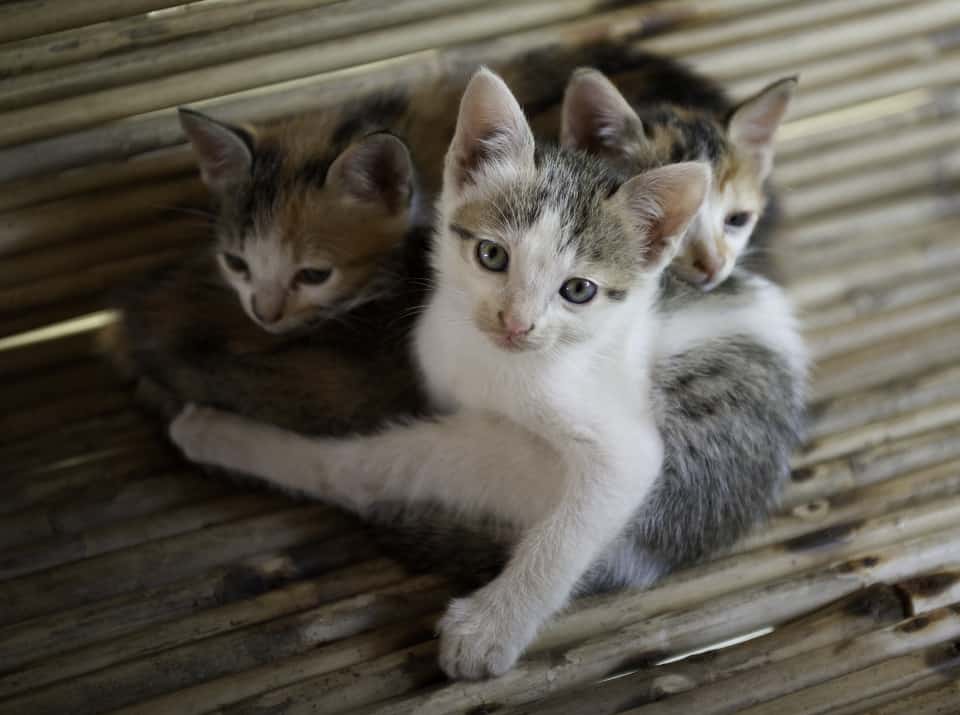A kitten can be a wonderful companion, but also a confusing creature at times. Cats are cryptic animals with minds of their own, and you’ll need to know a few things to make sense of what’s going on in that tiny furry head during the first year of your kitten’s life. The good news is that while cats are smart, you’re even smarter!
Kitten development in the first year is comprised of 4 key phases. By understanding the kitten development timeline, you can avoid confusion while raising a kitten and just focus on enjoying them all!
Kitten development first year
Phase 1: The first 6-8 weeks after birth
It takes a couple of months for a newborn kitten to become independent of his mother and ready to come home with you. You should be able to visit the cat breeder during this time, pick out your favorite little kitty and watch as he starts to explore his surroundings and find his instincts.
Prepare to be overwhelmed by cuteness watching this tiny predator stalk and pounce on his little brothers and sisters! This is the time when kittens begin to map out their immediate environment and become curious about the world. Expect them to find their way into the tiniest spaces and make sure you kitten proof your home so it’s a safe environment for adventure!
Save for: Vaccines and medical expenses
To keep your kitty safe from diseases, worms, fleas, and such, you’ll need to afford a few one-time medical expenses. Your vet will tell you everything you need to know, but you’ll have to be prepared for the bill. Except to pay around $500 in total. Microchip identification is another $70. You’ll also have to get a municipal pet license which should cost about $15 per year.
Phase 2: From 8 to 12 weeks
This is the time for learning such classic kitty-cat skills as chasing one’s own tail, climbing everything in sight (including you!), and chasing little moving things such as balls of string. Get a safe laser pointer from a pet store to shine around the floor for endless chasing fun!
Just like human children, kittens love games of “hide and seek” and exploring the spaces under furniture. Play with your kitten during this time to form a strong attachment that will last a lifetime!
Save for: Collar, bowls, litter box, bed, etc.
This stuff shouldn’t be too expensive unless you’re an Egyptian queen who needs her kitten to sleep on embroidered silk pillows and wear jewel-encrusted collars… about $200 should get you all you need in this department. If you’ve got some extra, consider purchasing a cat habitat with various parts to scratch, climb and squeeze through.
Phase 3: From 3 to 6 months
At the beginning of this period, your kitten will start teething and chew on things a bit more while the new teeth grow in. Irritated gums may make food less appealing for a while, but don’t worry, it’s just a phase.
The hunting instinct will be growing stronger and your kitten will also be exploring the social relationships and boundaries of his surroundings, challenging other cats (or humans!) for the title of “King of the Jungle”.
During these months, your kitten will start to lose his initial furball appearance and grow into the familiar cat shape. Like a teenager, a kitten at this age is fiercely independent but still needs plenty of love and attention! However, your kitten isn’t grown up yet and should continue to eat kitten food so as to get all the nutrients necessary for healthy growth.
Save for: Spaying or neutering
Unless you want eight more kittens right away, you’ll need to take a trip to the vet during this time. Expect to pay between $350-$500.
Phase 4: From 6 to 12 months
Your kitten is turning into a grown-up cat! Longer, taller, and more muscular, with the fluffy kitten hair being replaced by adult fur, this predator will move swiftly around the house, bouncing off tables, running along the back of the couch, etc.
This is also when they start to develop the classic cat personality, choosing to sit and observe more often than engage in action. Don’t worry if your kitten doesn’t seem as responsive to games as before or doesn’t run to the door to greet you every time you get home. It’s not depression, it’s just a normal part of becoming an adult cat.
Your cat is becoming more selective about his attention but will still enjoy curling up in your lap when there’s a chance!
Save for: Food and insurance
Expect your kitten to eat about $300 worth of food by the end of the first year. You should also have pet insurance so you’re covered just in case. That’ll run you another $350 or so.
Remember
The first year with your kitten is an exciting and unforgettable time that only happens once… unless of course, you get another! Kittens enjoy company. As long as you’re well prepared, it should be a wonderful time for both you and your furry friend.
Adding up all the necessities, the total cost of owning a kitten for the first year of his life will be up to $2000. A lot of the expenses will be concentrated toward the beginning of the year so it’s worth saving up before you rush into it.
Worrying about vet bills is one thing all pet owners will tell you they could do without. Be prepared and it won’t be a problem. Then you can focus on just enjoying this special time together!
